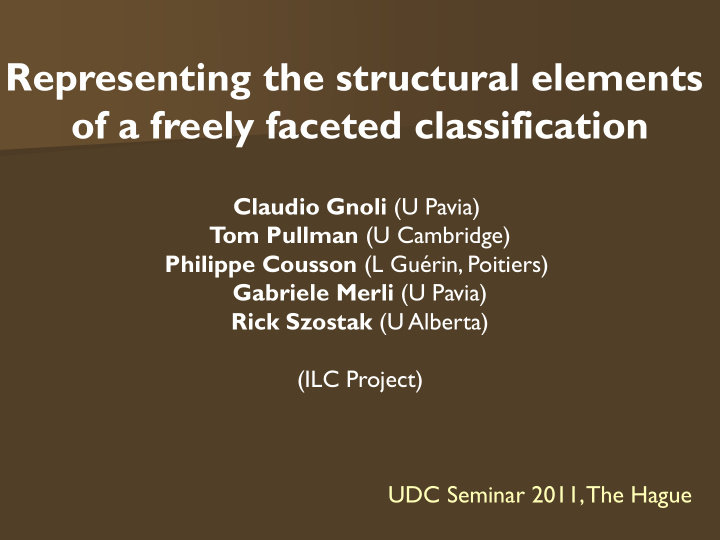



Representing the structural elements of a freely faceted classification Claudio Gnoli (U Pavia) T om Pullman (U Cambridge) Philippe Cousson (L Guérin, Poitiers) Gabriele Merli (U Pavia) Rick Szostak (U Alberta) (ILC Project) UDC Seminar 2011, The Hague
UDC Seminar 2009 Web-publish or perish !... [ Brickley , Soergel, Dunshire, Binding, Isaac…]
…but in which format? UNIMARC ? facets absent [Slavic & Cordeiro 2004; 2005] SKOS ? facets “postponed” [Miles 2008] OWL 2 ? [Zeng et al. 2010]
Facet analysis “the basis of all methods of IR” [CRG 1955; Broughton 2006] Available flavours: common auxiliaries [DDC, classic UDC] classic faceted classification [BC2, UDC revisions] freely faceted classification [CRG, ILC project]
Freely faceted classification Interdisciplinarity laws : vessels : oceans : whales : conservation laws ON conservation conservation OF whales whales IN oceans vessels IN oceans …
Freely faceted classification CRG-NATO draft scheme [1960s] V ILC draft scheme [2004-2011-] Development continues, but a stable published edition is needed for the sake of interoperability
ILC 1 Published on the Web, 2011-07-15 www.iskoi.org/ilc/1/ilc.php 7052 classes, browsable, searchable
ILC developing version www.iskoi.org/ilc/ilc.php Yellow background Also browsable, searchable
ILC database
Classification Notational plane knowledge representation Verbal plane Idea plane [Ranganathan]
Freely faceted classification Notational elements Arrays, Chains, Deictics, Facets, Foci, Place of definition of foci, Examples of combinations, Subclasses of a faceted class, Groupings, Related classes Verbal elements Main caption, Synonyms, Descriptions, Included terms, Related terms, Notes
Arrays Sensu Ranganathan Emptying digit z where >25 sister classes
Chains m organisms mq animals mqv chordates mqvt mammals mqvtn whales mqvtni dolphins mqvtnis Stenella Field for broader class in DBs for interoperability
Deictics Ranganathan’s “favoured host class” Extended in ILC
Facets etc. Facet Place of definition of foci Caption Synonyms Description
Example of combination nye estuaries m8 [ny] organisms, adapted to habitat m8e organisms , adapted to estuaries Extra-defined focus (“parallel division” of a facet)
Subclass of a faceted class The Genesis problem [Broughton 2010] js6 landforms, modelled by agent js6i landforms, modelled by wind js6i:l loess Relevant for common vs. civil law [Pullman p.c.]
Related classes In ILC, only dependence relationships are recorded: xxol alpinism « jsm mountains
Included terms
Related terms In ILC, disciplines:
Dynamic Web interface link to broader class expander link to details depth selector
Representation in SKOS mqvtn whales, cetaceans, cetacea V ilc:mqvtn rdf:type skos:Concept; skos:notation "mqvtn"^^ilc:ILCNotation; skos:broader ilc:mqvt; skos:prefLabel "whales"@en; skos:altLabel "cetaceans"@en; skos:altLabel "cetacea"@en.
How to represent facets? mqvtn2 [jU] whales, in area V ilc:mqvtn2 rdf:type skos:Concept; skos:notation "mqvtn2"^^ilc:ILCNotation; skos:prefLabel "in"@en; skos:altLabel "area"@en; skos:broader ilc:mqvtn; skos:broader ilc:2; skos:related ilc:jU.
How to represent facets? mqvtn2 [jU] whales, in area skos:broader ilc:mqvtn; skos:broader ilc:2; Facets are “narrower terms” of both their basic class ( mqvtn whales) and their fundamental category ( 2 in place )
Polyhierarchical model mqvt 2 “mammals” “in place” mqvtn2 “whales, in area ”
How to represent facets? mqvtn2 [jU] whales, in area skos:related ilc:jU Facets can be described as “related terms” of their place of definition ( jU regions) but this is not an effective instruction. Some extension of skos:related seems to be needed
How to represent facets? Clearly, these are but raw approximations Alternative: skos:collection but conceived for node labels in thesauri, not linkable to general categories
Facet combinations Not to be all enumerated in SKOS Possibly a converter ILC > SKOS (and back?) on demand
Other verbal terms description + its synonyms ~ skos:note + related discipline included terms ~ skos:example scope etc. notes ~ skos:definition
Conclusions Some elements of freely faceted cl’s are shared with other KOS types while others are peculiar Some of the latter (facet categories, place of definition…) are hard to be represented carefully in existing markup languages
Conclusions FFCs are complex, rich systems requiring special treatment More representation work is needed, possibly involving SKOS extensions or other markup languages
thanks www.iskoi.org/ilc
Recommend
More recommend